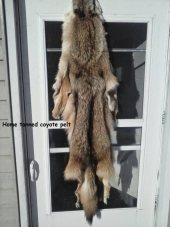Back with more. Wanted to chime in about tanning in a
permaculture context.
I actually hate bark tanning, in a sense. I don't like people looking at majestic trees and thinking "Wow that'd make some awesome leather/house/lumber, etc." I can't say for sure, but I would guess whole forests of Eastern Hemlock got chewed up for tanning leather when the Eastern/New England cities demanded it. That's not
sustainable in any sense. Cutting down whole trees--or windfall--on your homestead for a roundpole timberframe structure and using the bark on the side is one thing [Edit: for a long lasting super insulated house that will ultimately reduce total
wood usage]. Or bucking up some windfall trees for
firewood and gathering the bark before bucking. I've done that. I've gathered bark from windfall trees and from clearcuts (feller bunchers leave a lot of bark lying around). But I have never cut down a tree just to tan with it and never will.
Nor do I advocate anyone cutting down trees just to use the tree's bark. I have even got tannins from "beauty bark" (in the NW beauty bark is fir/hemlock) because it's there already chopped up ready to go, but I don't think beauty bark is part of a sustainable tanning scheme.
If there is to be a future: coppicing, leaves, and roots are the future of leather tanning.
Sumac is the number one guy worth mentioning because it grows in all 48 states. But another worth mentioning for arid/dry climates is Tanner's Dock. Here's a UC Berkeley Extension report on growing Tanner's Dock. (
https://openlibrary.org/books/OL25199150M/The_canaigre_or_tanners_dock ) I have friends who gather tanner's dock in washes outside Tuscon, AZ.
Tanner's Dock seed from Horizon Herbs:
https://www.horizonherbs.com/product.asp?specific=2657 (hardy to 20 F).
Coppicing schemes are of course a great option for getting bark from trees. In
The Woodland Year by Ben Law he shows that people coppice oak for the bark to make "fine medical leather" (all bark tan is non-toxic so it's more likely to be used in medical contexts). Some trees that coppice well and have high tannins are birch, willow, and chestnut. I would also investigate the tannin levels of green alder. I know red alder has some tannins (and fixes nitrogen) but it doesn't coppice.
Willow of course would make an awesome multi-function coppice plant: bark for tanning, suckers for rocket stoves, suckers for baskets, branches for fencing, etc. (Not all willow makes great basket material and willows vary in tannin content based on species and location).
Here's a super strange mainstream FAO report on coppicing willow for biomass/bioenergy production.
http://www.fao.org/docrep/008/a0026e/a0026e12.htm I don't advocate their scheme (edit: I support the science and experimentation, even the breeding, but not the use of heavy machinery as part of a "sustainable" scheme), but it does demonstrate that people are using willow seriously.
Salix eriocephala is used, which is also high in condensed tannins.
S. eriocephala ‘Russelliana' variety is sold by Willows Vermont for basketry and living structures (but they are out of it). (And I'm sorry to tease, but most places only
sell willow from Dec-March, although I gathered wild willow recently and it hadn't budded out yet).
I have even gathered doug fir bark with a willow pack basket...Rigid pack baskets made out of willow are awesome.








































 1
1





 1
1







